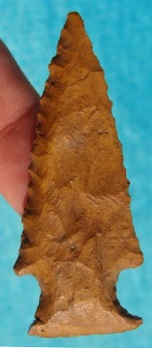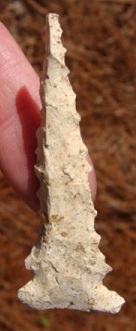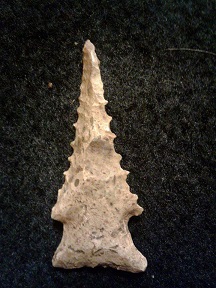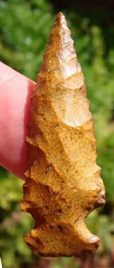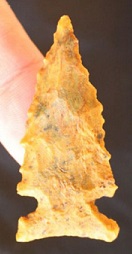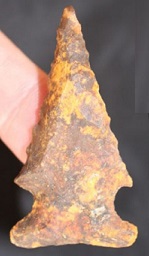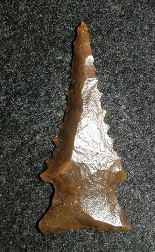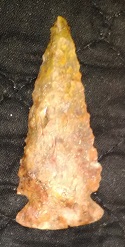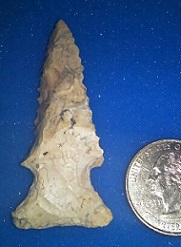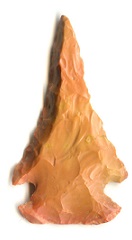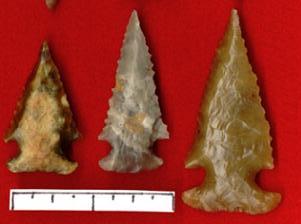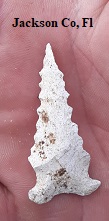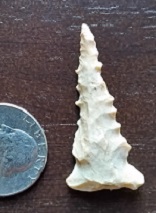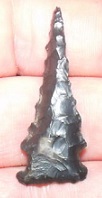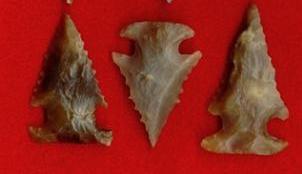Outline is Representative of Size and Shape:

Name Details:
Identified By: Wilfred T. Neill
Named For: Type Site
Date Identified: 1963
Type Site: Bolen Bluff Site, Florida
Identified By: Wilfred T. Neill
Named For: Type Site
Date Identified: 1963
Type Site: Bolen Bluff Site, Florida
Point Validity:
Valid type
Neill was a herpetologist who taught herpetology, ecology and archaeology at Pasco-Hernando Community College in Florida. He named this point in a professional publication and this type has many professional references. This is considered a valid type.
Neill was a herpetologist who taught herpetology, ecology and archaeology at Pasco-Hernando Community College in Florida. He named this point in a professional publication and this type has many professional references. This is considered a valid type.
Bolen Bevel
Cluster: Description of Physical Characteristics and Flaking Pattern:
This is a triangular small to medium side notch point with a flattened to elliptical cross section. The blade is primarily straight, but may vary from excurvate or incurvate and recurvate in re-sharpened examples. The most blades have serrations. The blade have beveling on one blade on each face. The shoulder may range from horizontal to barbed. The stem may vary from expanding to expanded. The base is convex. Basal grinding may be seen on this point. This point has a random flaking pattern.
Size Measurements:
Total Length - 26 to 95 mm (typically 40 to 50 mm), Stem Length - 9 to 15 mm (typically 10 mm), Width -20 to 38 mm (typically 26 to 32 mm), Stem Width - Typically slightly narrower than shoulders, Thickness - 5 to 12 mm (Different measurements to Bolen Plain and Bolen Expanded Notch)
Total Length - 26 to 95 mm (typically 40 to 50 mm), Stem Length - 9 to 15 mm (typically 10 mm), Width -20 to 38 mm (typically 26 to 32 mm), Stem Width - Typically slightly narrower than shoulders, Thickness - 5 to 12 mm (Different measurements to Bolen Plain and Bolen Expanded Notch)
Commonly Utilized Material:
Chert and coral
Chert and coral
Additional Comments:
Ripley Bullen identified five variants of the Bolen type point. The Bolen Type 1 is a side notched point with a straight base. This point is similar to the Big Sandy point, but is found in association with other Bolen style points. The Bolen Type 2 is similar to the Type 1, but has a convex base. The Bolen Type 3 is similar to a Kirk Corner Notch, but the stem is longer than is commonly seen on a Kirk type point. The Bolen Type 5 has a large square notch. This is the Expanded Notch type which is formed by flake removal from bit the top and the bottom of the notch. Other variants not identified by Bullen, but commonly used are the Bolen E Notch which is the Expanded Notch, but with a protrusion when the top and bottom flak met at the center of the notch. The Bolen Ace which is a re-sharpened type 2 which is not beveled and has an convex base giving the point an "Ace of Shapes" appearance. The last variant is the Bolen Recurvate which has a base that is recurvate having a center concave and the base rounding up at the basal corners (Lloyd Schroder, 2013 W18). All subtypes may have a plain blade edge, or have a beveled edge. See Bolen for pictures of each type
Ripley Bullen identified five variants of the Bolen type point. The Bolen Type 1 is a side notched point with a straight base. This point is similar to the Big Sandy point, but is found in association with other Bolen style points. The Bolen Type 2 is similar to the Type 1, but has a convex base. The Bolen Type 3 is similar to a Kirk Corner Notch, but the stem is longer than is commonly seen on a Kirk type point. The Bolen Type 5 has a large square notch. This is the Expanded Notch type which is formed by flake removal from bit the top and the bottom of the notch. Other variants not identified by Bullen, but commonly used are the Bolen E Notch which is the Expanded Notch, but with a protrusion when the top and bottom flak met at the center of the notch. The Bolen Ace which is a re-sharpened type 2 which is not beveled and has an convex base giving the point an "Ace of Shapes" appearance. The last variant is the Bolen Recurvate which has a base that is recurvate having a center concave and the base rounding up at the basal corners (Lloyd Schroder, 2013 W18). All subtypes may have a plain blade edge, or have a beveled edge. See Bolen for pictures of each type
Distribution: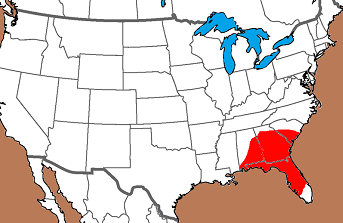

Distribution Comments:
This point is primarily found in northern Florida and as far north as Polk, Cobb, Bartow, and Cherokee county Georgia, southeastern Alabama, and east into the lower Savannah River Valley of South Carolina. This point may be found into central Florida with decreased frequency. This point has rarely been reported into Mississippi and Louisiana coastal regions.
This point is primarily found in northern Florida and as far north as Polk, Cobb, Bartow, and Cherokee county Georgia, southeastern Alabama, and east into the lower Savannah River Valley of South Carolina. This point may be found into central Florida with decreased frequency. This point has rarely been reported into Mississippi and Louisiana coastal regions.
Age / Periods:
Date: 9,500 - 8,500 B.P.
Cultural Period: Early Archaic
Glacial Period: Early Holocene
Culture:
Date: 9,500 - 8,500 B.P.
Cultural Period: Early Archaic
Glacial Period: Early Holocene
Culture:
Age Details:
Similar Points:
Big Sandy, Clay, Hardaway, Kirk Corner Notch, Lafayette, Lost Lake, Osceola Greenbrier, Taylor, Thebes
Big Sandy, Clay, Hardaway, Kirk Corner Notch, Lafayette, Lost Lake, Osceola Greenbrier, Taylor, Thebes

